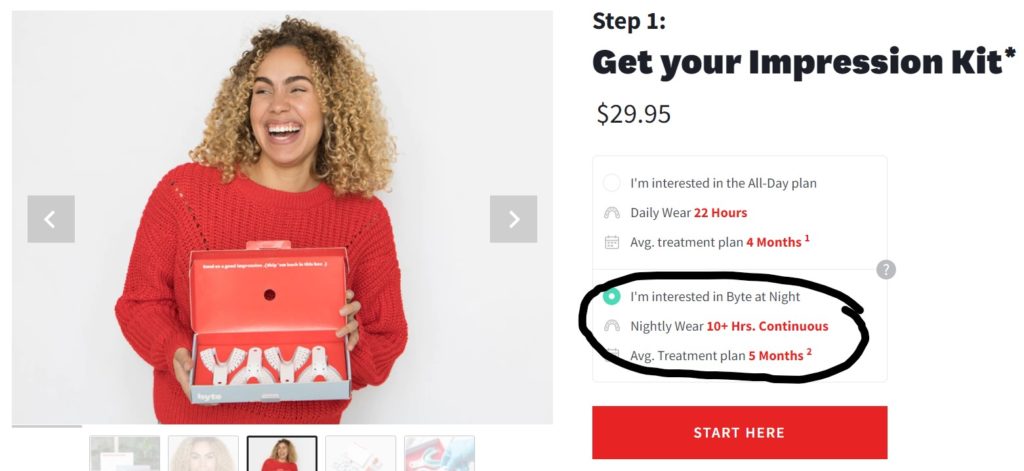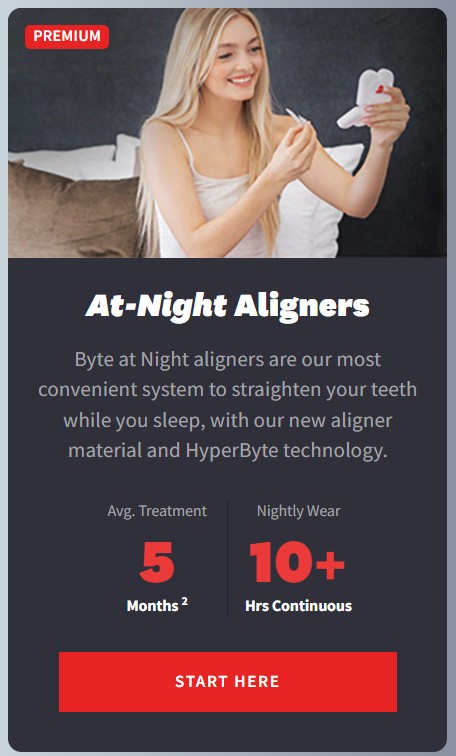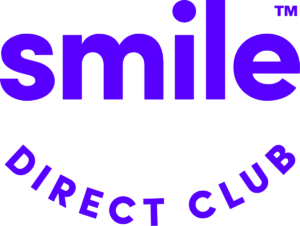Are you looking to get Invisalign night only braces?
For a low cost alternative to night-only Invisalign try Byte at Night – and save big on your impression kit with this link.
There are several good reasons to want braces that don’t have to be worn 24/7. For many, and particularly for self conscious adults who would rather not be seen wearing braces outside of their home, choosing nighttime aligners is a much better option than clear braces that have to be worn for most of the day, let alone traditional metal braces.
As a rule of thumb, Invisalign clear aligners have to be worn for 20-22 hours a day if they are to deliver your desired teeth straightening results on schedule. In spite of this, wearing your Invisalign braces at night only can seem like a tempting idea. But is it one worth pursuing?
In this article, we will be looking at the pros and cons of wearing your Invisalign aligners only at night, as well as present you with the best Invisalign alternative if you really need to wear your braces at night only. By the time you have read all the way to the end, you are going to have a much clearer idea of what your best orthodontic treatment options are.

From traditional metal braces to clear aligners
Traditional braces belong under the umbrella of traditional orthodontics. In fact, metal braces have been in use for over a hundred years at this point – though of course, metal braces today are much more sophisticated and effective than the often clunky and rudimentary braces that dentist were capable of producing a hundred years ago.
Invisible aligners are a much newer invention, and have only started gaining popularity and traction in the past few years. Technological advances have made it possible for orthodontists to create accurate scans or moulds of an individual’s teeth in order to accurately assess them and provide a tail0r-made treatment plan, often involving wearing a succession of 3D printed transparent aligners that slowly move any crooked, crowded or misaligned teeth from their original positions into a much straighter formation.
Out of all of the invisible aligners on the market today, there is one brand that scan be said to stand out among the competition – Invisalign. Invisalign has been around since the inception of invisible braces, and the company prides itself on having developed the most advanced clear aligner system in the world. It is through this system, and the million or so dentists that have been specially trained in applying it, that Invisalign has been able to treat more than 9 million patients with tooth problems as diverse as overbite, underbite, cross bite, open bite, gap teeth and crowding.
The first step when you want to start an Invisalign teeth straightening treatment is to book a consultation with your nearest Invisalign doctor. An Invisalign doctor is simply a dentist who has been specially trained in creating fast and precise 3D scans of your teeth using the iTero element scanner.
At your appointment, your Invisalign trained dentist is going to take the necessary scans and work out a custom treatment plan. Once you are happy with your plan, the treatment commences. If you want to wear your aligner set for less than the recommended 20-22 hours a day, you should discuss this with your Invisalign doctor at this initial consultation so that they can help create a plan for you that is both effective and seeks to meet your preferences as much as possible.
Once a treatment plan has been laid out and you have agreed to it, your first pair of braces is going to be created. All Invisalign braces are laser-trimmed to the gum line to ensure a perfect fit. When you pick up your first pair of Invisalign braces from your Invisalign trained dentist, they are going to help you fit them and make sure that everything looks and sits right.
During your treatment, you will be having checkups with your dentist every 6-8 weeks to ensure your treatment is progressing as it should.
Why Invisalign braces are not intended as night-only braces
Tempting as it is to only wear Invisalign braces at night, doing do is going to interfere with your teeth straightening process. This is why wearing your Invisalign clear aligners is really not recommended.
The reason you need to wear your invisible braces for up to 22 hours a day is so that your teeth don’t have the slightest opportunity to slip back into their original positions.
Being able to remove your at-home aligners is a great advantage when it comes to keeping both your braces and your teeth clean. Unlike traditional metal braces, which are stuck to your teeth for months at a time, invisible aligners are removable so you can take them out to eat and when you need to brush and floss your teeth. But while you can remove your invisible aligners for a few hours without having to worry about your teeth moving back to their default positions, leaving your aligners out for too long almost inevitably results in loosing some of the progress you have made on straightening your smile.
While your teeth straightening treatment is going to be a highly personal experience, tailor-made by your Invisalign doctor to best meet your individual dental needs, you are going to have to comply with wearing your invisible aligners for at least 20 hours out of every 24.
If you wear your Invisalign aligners less than the recommended 20-22 hours a day, you will be adding significantly to your overall treatment time. If you want to see quick results, not messing with or trying to tailor your teeth straightening treatment is by far the most effective option.
In most cases, you have no other option but to consistently wear your Invisalign clear aligners for 20-22 in order to achieve your teeth straightening goals on schedule. At least they are completely invisible, so wearing them outside of your home shouldn’t be too much of an inconvenience.
Best nighttime clear aligners
Invisalign may not offer nighttime clear aligners, but there are other clear aligner companies that do, and they are worth considering if you want braces for nighttime wear. Going with a different provider than Invisalign is a much better option than messing with the treatment that your Invisalign dentist has recommended.
Smile Direct Club
Smile Direct Club is a great alternative to Invisalign if you are in the market for nighttime aligners.
Not only does Smile Direct Club enable you to straighten your teeth for about half the cost of traditional braces, it also allows you to achieve the results you desire by only wearing aligners at night.
The first step toward a straighter smile with Smile Direct Club is to find out whether you are a suitable candidate, i.e. whether you would benefit from the Smile Direct Club treatment. This is assessed through the means of an impression kit, which is sent directly to you at home. The box includes everything you need to be able to make an accurate mould of your teeth, plus detailed instructions. You can also choose to come into your nearest Smile Direct Club location where a Smile Direct Club dentist will take a 3D scan of your teeth.
There are many parallels between the Invisalign and the Smile Direct Club experience. The one crucial difference seems to be that Smile Direct Club offer braces that are intended for nighttime wear, whereas Invisalign don’t.
It takes an average of 10 months to straighten your teeth with Smile Direct Club’s invisible nighttime aligners (As opposed to the average of 18 months it takes with traditional braces). Another pro of Smile Direct Club’s clear aligners is that they only have to be worn for ten hours a day – meaning you will never have to wear them out in public.
Nighttime aligners FAQ
What happens if I only wear my aligners at night?
In most cases, Invisalign aligners have to be worn 20-22 hours out of every 24 hours so that your teeth don’t slip back into their original positions.
However, some clear aligner companies offer nighttime aligners – aligners that have been developed specifically to help you achieve the results you desire despite a much shorter wear time of about 10 hours a day.
If you want to only wear braces at night, you should choose Smile Direct Club’s nighttime aligners or similar, rather than going with an aligner brand that requires longer wear times but cutting the time yourself. When it comes to something as important as your teeth, don’t experiment.
Can you straighten teeth just at night?
Yes, you can. While most invisible braces have to be worn consistently for 20-22 hours a day, some have been developed specifically for nighttime use. Smile Direct Club’s Nighttime Aligners are a great example. They only have to be worn for ten hours every 24 hours.
Can I wear Invisalign only at night?
Technically yes, you can. However, you should not try to change anything about your recommended teeth straightening plan, as this can cause delays to your treatment.
How much does night Invisalign cost?
Invisalign treatment can vary wildly depending on your individual teeth straightening needs. The average cost of Invisalign treatment ranges between three and five thousand dollars.
Nighttime aligners – are they the right orthodontic treatment for you?
The answer is almost certainly yes.
Unless your case is severe (Let us say, for example, that you have extremely crowded teeth or a prominent underbite), you can achieve a straight smile by wearing invisible aligners only at night, and for as little as ten months.
Smile Direct Club offers the revolutionary Nighttime Aligners that have been developed specifically with the aim of moving teeth in increments of ten hours a day. If you want to be able to straighten your teeth as discreetly as possible, there is no better way to go about it.







